André Grétry’s opéra-ballet La caravane du Caire is certainly not fashioned for the MeToo# age. It was given a private performance at Fontainebleau in 1783 and then presented the following year at the Académie Royale de Musique (later renamed the Paris Opéra). It has a distinctly partisan agenda, with the Belgian-born, Italian-trained André-Ernest-Modeste Grétry (1741–1813), who settled in Paris and became a French citizen, using eighteenth-century attitudes to the ‘East’ to present a portrait of his adopted nation in which the men were gallant, sensitive and courageous and the women were graceful, sensuous and charming.
Whether one shares Grétry’s Francophilia or not, attitudes to the ‘Orient’ have moved on somewhat in the last 250 years. But, taken for what it is, rather than what it might be, La caravane du Caire has a melodious charm and infectious energy, as this colourful and captivating production by director Marshall Pynkoski at the Royal Opera, Versailles confirmed.
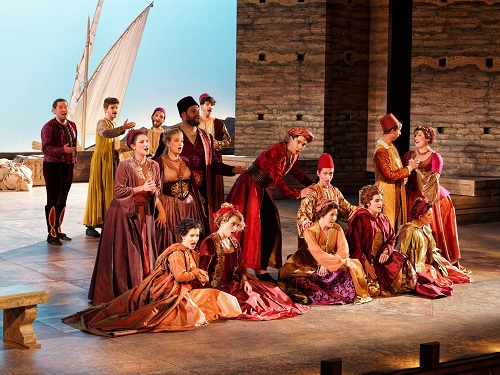
Comprising three acts, which are populated with marches and ballets alongside arias and ensembles linked by sung recitative, La caravane presents a detailed, vibrant vision of ‘foreign life’ in the Ottoman-controlled Middle East. A slave caravan has stopped beside the river Nile, on its way to Cairo. Among the trader Husca’s captives are two beloveds, Saint-Phar, the son of a French officer, Florestan, and Zélime, the daughter of an Indian chief. When the caravan is attacked by marauding Arabs, brave Saint-Phar beats back the assailants and earns his freedom, but Husca refuses to release Zélime. He’s saving her for the Osman Pasha in Cairo – one of whose ships has just been saved by Florestan – who has become bored with the most favoured of his harem, Almaïde. The eunuch Tamorin and Husca present the latter’s ‘wares’ to the Pasha at the slave bazaar and he chooses Zélime.
Saint-Phar plots with the scorned Almaïde to rescue Zélime from the harem, and while a celebration for Florestan, who laments his lost son, and the French officers is underway, news comes of her abduction by an unknown Frenchman. No punishment must be spared, declares Florestan! But, when Zélime is captured and her kidnapper revealed, Florestan is forced to plead for his son. The Pasha has a change of heart, the lovers are reunited and Almaïde restored in the Pacha’s affections. The tale may seem simple, clichéd even, but it’s told with wit and drollery.
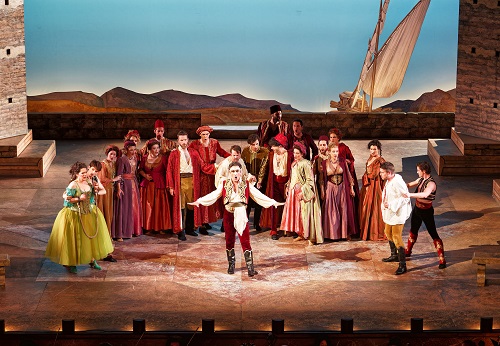
The action is somewhat episodic, but Pynkoski keeps things moving slickly along – indeed, there was scarcely a breath in which the audience might applause. Much of this fluency is owing to the sleight-of-hand smoothness with which the various locales of Antoine Fontaine’s sets segue, as periaktoi spin, columns revolve and latticework slides, transporting us in a blink from the blue azure of the Nile-side vista to the gilded luxury of the Pacha’s palace and on to the bustling exuberance of the Cairo slave market. Outside and inside are lit with equal magic by Hervé Gary, and the designs both convey the ‘realism’ of Cairo life and create striking theatre. Notable were Florestan’s farewell – a magically lit ‘ocean’ of undulating blue silk, perfectly coordinated to frame the Frenchman’s departure – and the extended celebratory ballet after the final Act, sung with choral exuberance, brilliantly choreographed and executed in a glittering shower of gold confetti. Add Camille Assaf’s gorgeously detailed costumes – a riot of colour and textural richness – and it’s a true feast for the eyes.
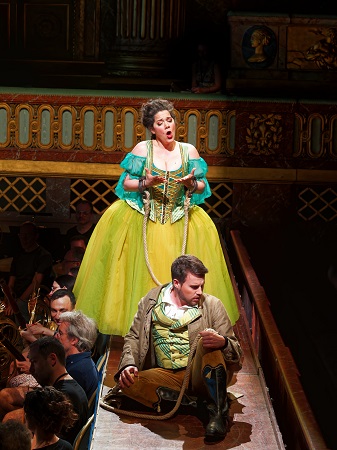
And, at Versailles, a treat for the ears, too. The arias trip along as lightly as the dancers’ feet, and they were sung by all with both artistry and affection. As the divided lovers, tenor Pierre Derhet and soprano Hélène Guilmette were a well-matched pair, Derhet capturing Saint-Phar’s heroism and impetuosity – his anger was fierce in ‘Va, va, cruel’ – Guilmette’s glowing tone conveying Zélime’s intensity and sincerity. Flamboyantly dressed in black and gold, and with leonine tresses, Robert Gleadow’s Pasha was appropriately larger than life. He nailed the tongue-in-cheekness of the role perfectly, his bass as agile as his facial expressions as he lauded the virtues of the French in ‘Oui, oui, toujours’ and seeming genuinely, if foolishly, captivated by Zélime, in ‘C’est en vain qu’Almaïde encore’. He might be the ‘villain’ of the piece, but this Pasha’s final act of generosity didn’t come as a surprise.
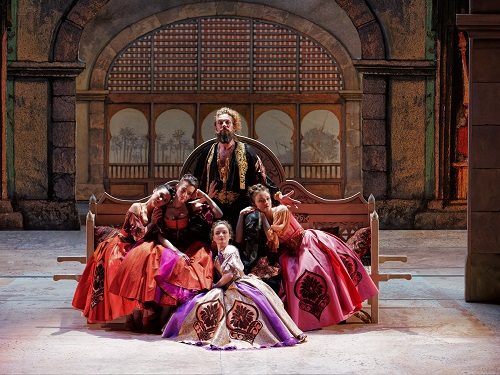
Jean-Gabriel Saint-Martin relished the impish guile of the slave trader, Husca – a grotesque mask adding to his outrageousness and suggesting the commedia – but in the final Act his baritone acquired a fitting gravity and ringing warmth as Florestan, especially when telling of his sadness at his son’s disappearance, ‘Ah! si pour la patrie’. In the high tenor role of the Pasha’s eunuch, Tamorin, Enguerrand de Hys was utterly persuasive as he deftly manipulated all around him, including his master, suggesting to the latter that a dash of infidelity might spice up the monotony – and, he knew the perfect French mademoiselles … de Hys despatched this testing aria with aplomb, a sort of Leporello-in-reverse.
Soprano Marie Perbost was a graceful Almaïde though there was plenty of fire when she sang of her jealousy of Zélime, in the melodious ‘Je souffrais qu’un rival’. The Act 2 slave market scene comprises several ‘set piece’ arias for Husca’s enslaved ladies. Accompanied by harp and strings, soprano Lili Aymonino was charming in the French slave’s lyrical air, while soprano Chantal Santon Jeffery whizzed with ease through the Italian slave’s ‘opera seria’ flounces and flourishes. A folk-like contrast was offered by the German slave girl’s number, sung warmly by mezzo-soprano Lucie Edel. Bass-baritone Benoît Descamps and bass Samuel Guibal were accomplished in the small roles of Osmin and Furville.
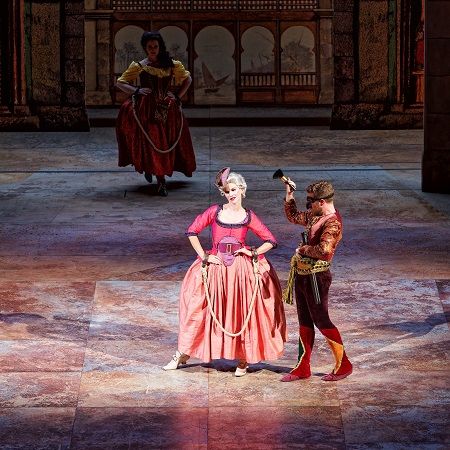
Dance dominates the divertissements in Act 2, and the eight dancers of the Ballet Royal offered fine entertainment – those dance-loving eighteenth-century audiences would have been impressed and satisfied. Elsewhere some of the dances do complement the action: the Arabs’ onslaught was excitingly rendered by a polished, in every sense, ‘sword dance’.
Circled by the players of the Concert Spirituel, with woodwind and brass behind him, Hervé Niquet drew virile, clean-textured playing from his musicians, with economic, crisp means and methods. Tempi were swift, but always supportive of the singers. The woodwind players made much of their solos, adding rich sonorities and hues. The grace of the melodies was balanced by the slight rawness of the pseudo-égyptienne touches, and to this ‘local colour’ and Grétry adds some genuine middle Eastern instruments creating a lively buzz in the finale.
During his lifetime Grétry, who had been private music director to Queen Marie-Antoinette, composed (or collaborated upon) 69 operas and was fêted as the pre-eminent composer of opéra-comique. His funeral cortège was reputedly watched by 300,000 people – half the population of Paris! La caravane received more than 500 performances at the Opéra before 1829, and sold more than one million tickets. In her memoirs, the Baroness d’Oberkirch noted, ‘The lyrics and music are bad, but the staging, dancing and costumes sufficed to attract the whole of France’. An ‘exotic and irrational entertainment’ La caravane may seem today but, capturing the music’s excitement, passion and voluptuousness, Pynkoski and his super cast and musicians confirmed that it’s an entertainment of terrific character and charisma.
Claire Seymour
Zélime – Hélène Guilmette, Husca/Florestan – Jean-Gabriel Saint-Martin, Almaïde – Marie Perbost, Saint-Phar – Pierre Derhet, Tamorin – Enguerrand de Hys, Osman Pacha – Robert Gleadow, French slave – Lili Aymonino, Italian slave – Chantal Santon Jeffery, German slave – Lucie Edel, Osmin – Benoît Descamps, Furville – Samuel Guibal, Dancers (Emma Brest, Malory Delenclos, Vincent Gerbet, Margritte Gouin, Ludovick Le Floc’h, Laurine Ristroph, Nicolas Rombaut and Dominic Who); Director – Marshall Pynkoski, Conductor – Hervé Niquet, Set design – Antoine Fontaine, Costume Design – Camille Assaf, Lighting design – Hervé Gary, Royal Opera Ballet, Le Concert Spirituel Choir and Orchestra
Chapelle Royale, Versailles; Sunday 11th June 2023.
ABOVE: La caravane du Caire © Pascal Le Mée